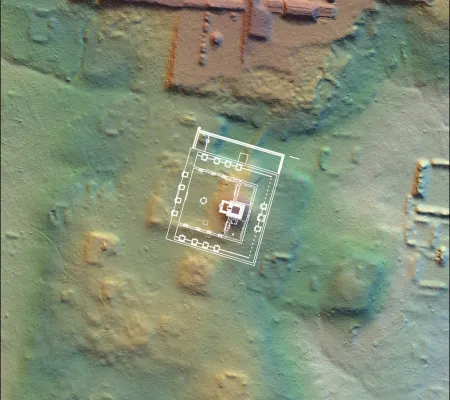A laser-based sensing technique utilized by a ground team led by UT alumnus and Guatemalan archaeologist Edwin Román-Ramirez (PhD in Latin American Studies, 2017; MA, 2011), and including UT Art History Professor and Mesoamerica Center Director David Stuart and UT archaeologist Thomas Garrison, has revealed the presence of a precinct at the Classic Maya city of Tikal that most likely reproduces a significant temple within the imperial capital of Teotihuacán.
The ancient Maya metropolis of Tikal in Guatemala has been the subject of archaeological research for over 70 years with much current research being driven and funded by a research consortium, Fundación Patrimonio Cultural y Natural Maya (Pacunam) Lidar Initiative. Stuart’s own role in the research on Tikal dates back over 20 years, when he first identified the historical records of Teotihuacán's conquest of Tikal in AD 378, which pointed the way forward for current investigations. This most recent finding, published in Antiquity, includes confirmation of the existence of a large enclosed plaza, with a pyramid along its eastern side. This discovery suggests a closer relationship between Tikal and Teotihuacán than previously thought.
Where there was thought to be a natural hill soon came to be identified as a smaller scale replica of the ‘Ciudadela’ (the citadel) at Teotihuacan, “along with, on its eastern side, a building in the same position as the celebrated Temple of the Feathered Serpent,” reads the study. “The Ciudadela at Tikal was approximately 30 per cent smaller than its exemplar at Teotihuacan, yet it had the same north–south wings on the eastern pyramid, an enclosed square plaza in front and a reservoir (called the ‘Madeira’) in place of the canal to the north of the complex at Teotihuacan.”
According to Stephen Houston, a professor of anthropology at Brown University who is also involved with the Pacunam consortium, some archaeologists thought that ‘contact between Teotihuacán and Maya kingdoms was light or only involved long-distance copying,’ but the discovery of the new complex points to ‘a far more intense, tighter level of contact.’”
Aside from architectural influences, human remains were found close to the pyramid, with evidence pointing to the bodies having been deliberately burned, a ritual mirroring burials of warriors done in the citadel in Teotihuacán.
Stuart said, “This fall our UT team was excited to visit Tikal and check out the newest excavations. The evidence for Teotihuacan’s presence is now even stronger than before. The collaborations at Tikal will be continuing for some time, now that we have some detailed history to help us contextualize the next stage of the archaeology.”
“This groundbreaking research shows how we can work collaboratively with our partners to unearth new knowledge about ancient civilizations. It is a beautiful showcase of our efforts to advance breath and depth of knowledge, historical and contemporary, of the expansive Mayan world,” said Ramón H. Rivera-Servera, dean of the College of Fine Arts. “We’re proud of the scholarship from our UT faculty members, who are opening new paths of inquiry within their field.”


